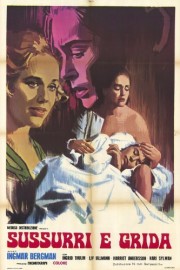Cries and Whispers
Ingmar Bergman’s primary role as a filmmaker was to chronicle the pain of life. Yes, there are moments of great compassion and love in his films, but pain is the driving force of many of his movies. That is never more true than in “Cries and Whispers,” in which a servant (Anna, played by Kari Sylwan) is witness to great agony and cruelty, as her ward, Agnes (Harriet Andersson) is dying, and her sisters, Maria (Liv Ullmann) and Karin (Ingrid Thulin), are staying at the manor as Agnes’s health deteriorates. This isn’t a loving relationship between the sisters, though; Maria and Karin are awful women, both despising their husbands, and cold towards Anna, who seems to be the only one who truly loves Agnes. Perhaps they care for Agnes, but sometimes they seem simply helpless at trying to do something for their sister. Anna, on the other hand, is quick to rush to her side when she is in agony, unafraid of seeing her writhing in pain.
Bergman’s films are among the richest treasures of world cinema– filled with tremendous feeling and calculating pessimism all at once. He was a filmmaker who wasn’t afraid of asking profound questions of a God he was unsure existed, and was unafraid of showing his characters as having genuine spiritual faith; in this film, the latter comes from Anna, who has the most gentle heart of any of the characters in the movie. How Anna is treated after Agnes dies, simply as the “hired help” rather than the profound companion she was to their sister, is heartbreaking to watch. This film is about the lower depths of pain that people can feel, and tragically, inflict on others. Watch Maria’s indifference after her husband stabs himself when he learns of her infidelity. And Karin’s heartless cruelty to her own body out of spite for her husband. And contrast those moments with the outpouring of sympathy Anna feels towards Agnes, even after she dies.
The film is structured quite unusually by Bergman, who moves between flashbacks and the present without warning, except for the screen turning red when we return to the present. Color is important to the film’s impact, more so than in any other Bergman film I’ve seen that wasn’t in black-and-white. The cinematography is by Sven Nykvist, Bergman’s great collaborator, and the use of color in a way that works as both realism and metaphor in this film is stunning. Red is seen throughout the film, and the contrast between the white the women wear before Agnes dies, and the black they wear after she dies, is startling, and wouldn’t have been quite as noticeable had the film been in black-and-white. Color is a vital part of the film’s success, because the deliberate choices in colors make the emotions come alive just a bit more; the rare moments of tenderness are lended greater significance, while the hatred comes through with the twist of a knife. More so than Bergman, Nykvist is the film’s MVP, by making the emotions of “Cries and Whispers” impossible to keep out, or shake after the film is over.










